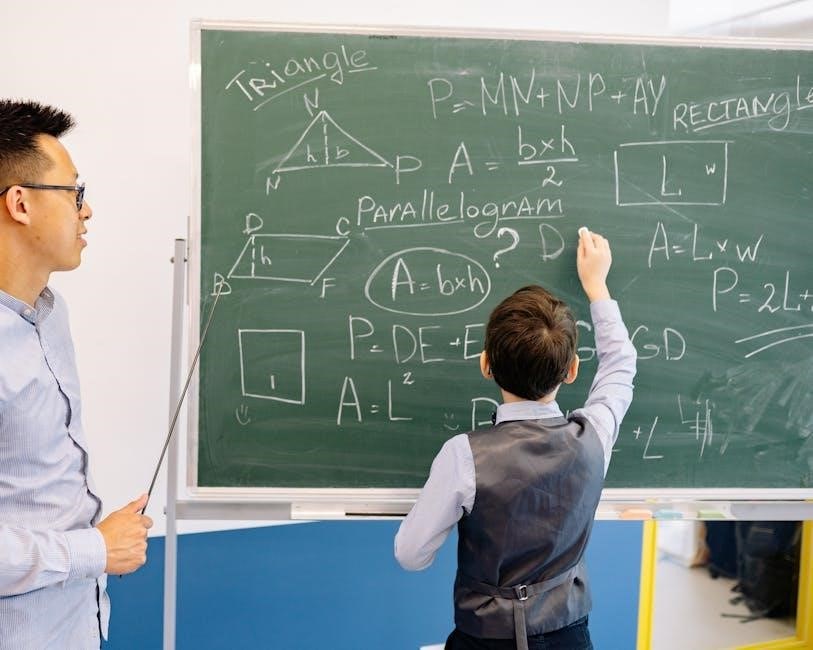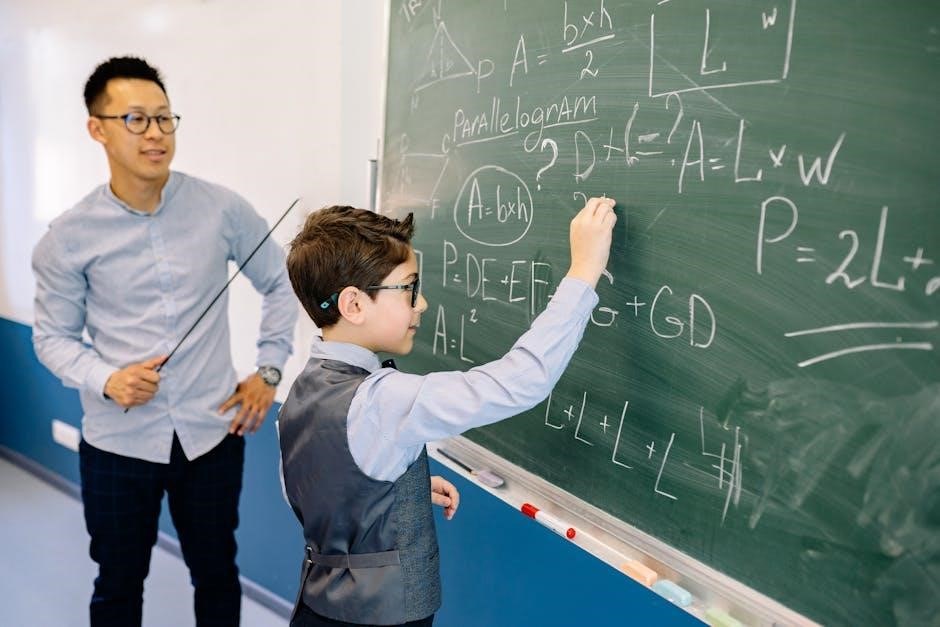Two-step equations are fundamental algebraic problems requiring two operations to solve. They involve variables and constants, often arising in real-world scenarios, making them essential for practical problem-solving skills.
1.1 Definition of Two-Step Equations
Two-step equations are algebraic expressions that require two separate operations to solve for the variable. These equations involve a combination of multiplication, division, addition, or subtraction, applied in sequence. For example, an equation like 3(x + 4) = 12 requires first dividing by 3 and then subtracting 4 to find the value of x. They are called “two-step” because solving them involves two distinct mathematical operations. Two-step equations are foundational in algebra and are often used to model real-world problems, making them essential for developing problem-solving skills.
1.2 Importance of Solving Two-Step Equations
Solving two-step equations is crucial for developing foundational algebraic skills and logical thinking. These equations model real-world problems, helping students connect math to everyday scenarios. Mastering two-step equations enhances problem-solving abilities, builds confidence, and prepares learners for more complex algebraic concepts. They are essential for understanding how to break down problems into manageable steps, a skill vital in STEM fields and practical decision-making. Solving these equations also improves analytical reasoning, making them a cornerstone of mathematical literacy and a stepping stone for advanced problem-solving.

Understanding Word Problems
Word problems involve translating real-life scenarios into mathematical expressions. They require interpreting language to form equations, making them practical for applying algebraic concepts to everyday situations.
2.1 Definition of Word Problems
Word problems are mathematical exercises presented in textual form, describing real-life scenarios. They require translating words into algebraic expressions and solving using appropriate operations. These problems often involve multiple steps, making them ideal for practicing two-step equations. By linking math to everyday situations, word problems enhance understanding and application of algebraic concepts. They are widely used in education to develop critical thinking and problem-solving skills, preparing students for practical challenges beyond the classroom environment.
2.2 Key Characteristics of Word Problems
Word problems typically involve real-life scenarios, requiring students to interpret and translate language into mathematical expressions. They often incorporate multiple operations, such as addition, subtraction, multiplication, or division, and may involve unknown variables. These problems are designed to assess a student’s ability to apply mathematical concepts to practical situations. Word problems frequently include specific keywords that indicate the operations needed, such as “twice as many” or “divided equally.” They also often require a sequential approach, making them ideal for practicing two-step equations and reinforcing problem-solving strategies.

Components of Two-Step Equations
Two-step equations involve variables and constants, requiring two operations to solve. They often include addition, subtraction, multiplication, or division, and are frequently used in word problems.
3.1 Operations Involved in Two-Step Equations
Two-step equations involve a combination of basic arithmetic operations such as addition, subtraction, multiplication, or division. These operations are applied sequentially, requiring the solver to follow the order of operations (PEMDAS). Word problems often translate into equations where one operation is performed first, followed by another. For example, combining items may involve addition, while removing items requires subtraction. The ability to identify and apply these operations in the correct sequence is crucial for solving two-step equations accurately. This foundational skill is essential for tackling more complex mathematical problems in the future.
3.2 Variables and Constants in Equations
In two-step equations, variables represent unknown values, while constants are fixed numerical values. Variables allow equations to model real-world problems, making them solvable for unknown quantities. Constants provide the fixed values necessary to form the equation. Together, variables and constants enable the creation of balanced equations that can be solved using algebraic methods. Understanding the role of both is essential for translating word problems into mathematical expressions and solving them accurately. This combination of elements forms the backbone of two-step equations, making them versatile tools for problem-solving in various contexts.

Creating Two-Step Equations from Word Problems
Creating two-step equations involves translating words into mathematical expressions. Identify keywords like “more than” or “twice as,” which indicate operations, and structure the equation accordingly, ensuring it requires two steps to solve.
4.1 Identifying Keywords and Phrases
Identifying keywords is crucial for translating word problems into equations. Phrases like “more than,” “twice as,” or “combined” indicate addition or multiplication. Verbs such as “bought,” “spent,” or “gave” signal specific actions. Quantifiers like “each” or “total” help define variables. Prepositions like “of” or “from” clarify relationships. By pinpointing these terms, students can map words to operations and variables, forming accurate two-step equations that reflect the problem’s context and lead to the correct solution.
4.2 Translating Words into Mathematical Expressions
Translating words into math expressions involves converting keywords into operations and variables. Phrases like “twice as many” become 2x, while “more than” indicates addition. For example, “She baked 4 more than three times the total she made last week” translates to 3x + 4. Similarly, “total cost” might involve adding a registration fee and membership cost, such as 160 + 28. By breaking down sentences and assigning operations to actions, students can create accurate two-step equations that reflect the problem’s context, enabling them to solve it systematically.
Solving Two-Step Word Problems
Solving two-step word problems involves identifying operations, setting up equations, and solving systematically. This approach ensures clarity and accuracy, making real-world applications manageable and understandable for learners.
5.1 Step-by-Step Approach to Solving
Solving two-step word problems requires a systematic approach. First, identify the information given and what needs to be found. Next, translate the words into a mathematical equation, ensuring the operations align with the problem’s context. Once the equation is set up, perform the operations in the correct order, reversing the operations applied to the variable. Finally, verify the solution by substituting it back into the original problem to ensure accuracy. This method ensures clarity and reduces errors, making complex problems manageable and solvable. Real-life examples, such as calculating total costs or quantities, further illustrate this approach.
5.2 Checking Solutions for Accuracy
After solving a two-step word problem, it’s crucial to verify the solution. Substitute the found value back into the original equation to ensure both sides balance. This step confirms the correctness of the solution. Additionally, reviewing each algebraic step helps identify any calculation errors. Reflecting on the problem’s context can also reveal if the answer makes logical sense. Regularly checking solutions builds confidence and reinforces problem-solving skills, making learners more adept at handling various word problems effectively and efficiently in their studies and real-life applications.
Real-World Applications of Two-Step Equations
Two-step equations are essential for real-world scenarios, such as calculating total costs, budget planning, and resource distribution. They simplify complex problems into manageable solutions.
6.1 Practical Scenarios Involving Two-Step Equations
Practical scenarios involving two-step equations include budget planning, calculating total costs, and resource distribution. For instance, determining the number of items that can be purchased within a budget or calculating the total time required for a task involving multiple steps. These scenarios are common in everyday life, such as planning events, managing finances, and solving problems at work or home. They help individuals develop critical thinking and problem-solving skills, making math applicable and relevant to real-life situations. These applications highlight the importance of mastering two-step equations for practical purposes.
6.2 Everyday Problems That Can Be Solved Using Two-Step Equations
Everyday problems that can be solved using two-step equations include calculating total costs, splitting bills, or determining quantities in recipes. For example, if a pizza costs $12 and a drink costs $3, and a 10% tax is added, the total amount can be found using a two-step equation. Similarly, figuring out how many items can be bought within a budget or how much change to expect after a purchase involves these equations. They are essential for practical decision-making, making math relevant to daily life and enhancing problem-solving abilities in various real-world contexts.

Common Types of Two-Step Word Problems
Two-step word problems often involve combining or adding items and scenarios requiring subtraction or removal. These problems mirror real-life situations, enhancing practical math skills.
7.1 Combining and Adding Items
Combining and adding items in two-step word problems typically involves scenarios where quantities are merged or accumulated. For example, problems might describe adding groups of objects, such as John buying pencils one week and more the next. These situations require setting up equations that first combine items and then perform another operation, like doubling the total. Worksheets often include exercises where students translate these narratives into mathematical expressions, solving them step-by-step to find the unknown variable. This process enhances understanding of algebraic operations and their real-world applications.
7.2 Taking Away or Removing Items
Taking away or removing items in two-step word problems often involves scenarios where a quantity is reduced or distributed. For example, problems might describe giving away toys, sharing candies, or subtracting a certain number from an initial amount. These situations require setting up equations that first combine items and then involve subtraction or division. Worksheets include exercises where students translate these narratives into mathematical expressions, solving them step-by-step to find the unknown variable. This process reinforces algebraic reasoning and practical problem-solving skills, making it easier to apply to real-life situations.
Resources for Practicing Two-Step Equations
Free PDF worksheets from Cuemath and Kuta Software offer comprehensive practice for two-step equations and word problems, providing step-by-step solutions and real-world applications for better understanding.
8.1 Free Worksheets Available Online
Various websites like Cuemath and Kuta Software offer free downloadable PDF worksheets for two-step equations and word problems. These resources provide a variety of problems, including real-life scenarios, mixed operations, and step-by-step solutions. They cater to different skill levels, from basic to challenging, ensuring thorough practice. Educators and students can access these materials without cost, making them ideal for homework, classroom activities, or self-study. The worksheets are designed to enhance problem-solving skills and understanding of algebraic concepts in an engaging and structured manner.
8.2 Recommended Websites for Downloading Worksheets
Recommended websites for downloading two-step equations word problems worksheets include Kuta Software, Cuemath, and Worksheet Genius. These platforms offer free PDF resources with varying difficulty levels. Kuta Software provides customizable worksheets, while Cuemath offers structured, themed worksheets. Worksheet Genius includes mixed operations and word problems. Additionally, MathWorks and Teachers Pay Teachers are excellent sources for real-world application problems. These websites cater to different learning needs, ensuring students and educators can access high-quality materials for practice and teaching purposes, enhancing problem-solving and algebraic skills effectively.
Tips and Strategies for Solving Two-Step Word Problems
Understand the problem, identify keywords, and break it into manageable steps. Highlight key terms, translate words into math, and solve systematically. Use visual aids and check solutions for accuracy to ensure understanding and correctness.
9.1 Breaking Down Complex Problems
Breaking down complex problems involves identifying key components and simplifying them. Start by reading the problem carefully to understand the scenario. Highlight or underline important terms and numbers. Next, determine the unknown variable and what needs to be found. Translate the words into a mathematical equation, ensuring each step is clear. Use visual aids like diagrams or charts to organize information. Solve one step at a time, checking each part for accuracy. This methodical approach helps in managing intricate word problems effectively and reduces errors.
9.2 Using Visual Aids for Better Understanding
Visual aids are powerful tools for simplifying complex word problems. Diagrams, charts, and flowcharts help students visualize relationships between quantities. For example, drawing a bar model can represent unknowns and operations clearly. Highlighting keywords and translating them into mathematical symbols ensures clarity. Using color-coded steps can differentiate between operations, making it easier to follow. Visual aids also help identify patterns and connections, reducing confusion. They are particularly effective for kinesthetic and visual learners, enhancing engagement and comprehension. Incorporating images or real-life representations makes abstract concepts more tangible, leading to better retention and problem-solving skills.

Common Mistakes to Avoid
- Misinterpreting keywords, leading to incorrect operations.
- Reversing the order of operations unintentionally.
10.1 Misinterpreting Keywords and Phrases
One common mistake is misinterpreting keywords in word problems. For example, “twice as many” might be confused with “two more than,” leading to incorrect equations. Additionally, phrases like “divided among” or “combined with” can be tricky, as they require careful translation into mathematical operations. It’s essential to read problems slowly and identify each keyword’s meaning to set up the correct equation. Practicing with various word problems helps improve interpretation skills and reduces errors in solving two-step equations.
10.2 Reversing the Order of Operations
A common error when solving two-step equations is reversing the order of operations. For instance, if an equation involves both multiplication and addition, performing addition before multiplication can lead to incorrect results. This mistake often occurs when translating word problems into mathematical expressions. To avoid this, it’s crucial to identify and apply operations in the correct sequence, as dictated by the problem’s context. Practicing with worksheets that highlight such errors can help build awareness and improve accuracy in solving two-step equations. Always refer to examples provided in practice materials to reinforce proper techniques.

Interactive Tools for Learning
Interactive tools, such as online simulators and educational apps, provide engaging ways to practice two-step equations. These resources offer real-time feedback, enhancing understanding and retention of concepts.
11.1 Online Simulators and Calculators
Online simulators and calculators are powerful tools for practicing two-step equations. They provide interactive platforms where students can input their solutions and receive immediate feedback. These tools often include step-by-step guides, helping learners understand where they might have gone wrong. Websites like Cuemath and Kuta Software offer free access to such resources, making learning accessible and convenient. Additionally, some simulators allow users to generate custom problems, catering to individual learning needs. These digital aids not only enhance problem-solving skills but also build confidence in tackling word problems effectively. They are invaluable for both classroom and self-study environments.
11.2 Educational Apps for Practicing Two-Step Equations
Educational apps like Khan Academy, Duolingo, and Photomath offer interactive tools for mastering two-step equations. These apps provide step-by-step solutions, quizzes, and hints to guide learners. Many apps include video tutorials and adaptive learning features, tailoring the difficulty to the user’s skill level. They also track progress, offering insights into areas needing improvement. Mobile accessibility makes learning convenient, allowing students to practice anytime. Such apps are ideal for students seeking to reinforce their understanding of two-step equations and word problems, offering a engaging and personalized approach to math practice.

Assessment and Feedback
Assessment involves evaluating student understanding through quizzes and worksheets. Feedback provides insights into strengths and areas for improvement, helping students refine their problem-solving skills effectively.
12.1 Evaluating Student Understanding
Evaluating student understanding involves reviewing their ability to translate word problems into two-step equations and solve them accurately. Teachers can use worksheets to assess problem-solving skills, ensuring students can interpret keywords and apply appropriate operations. Feedback should highlight correct equation setup and solution processes. Common errors, such as misapplying operations or miscalculating, should be addressed to guide improvement. Detailed comments help students identify areas needing refinement, fostering a deeper grasp of two-step equations and their real-world applications.
12.2 Providing Constructive Feedback
Constructive feedback is crucial for helping students improve their understanding of two-step equations. Teachers should review worksheets, highlighting correct equation setups and solutions while addressing errors. Feedback should guide students in refining their problem-solving skills, such as interpreting keywords and applying operations accurately. Detailed comments can help students identify areas for improvement, fostering a deeper understanding of algebraic concepts and their application to word problems. Positive reinforcement for correct answers and specific suggestions for revising mistakes encourage growth and confidence in solving two-step equations.
Extending Learning Beyond Worksheets
Engage students in interactive activities, such as real-world projects and group discussions, to deepen their understanding of two-step equations beyond traditional worksheet exercises and challenges.
13.1 Incorporating Real-Life Scenarios
Incorporating real-life scenarios into learning helps students connect two-step equations to everyday situations, such as budgeting, cooking, or planning events. For example, calculating total costs at McDonald’s or determining quantities for a party. These practical examples make learning engaging and relevant, encouraging students to apply mathematical skills to real-world problems. By using relatable contexts, educators can enhance understanding and retention of two-step equations, preparing students for practical problem-solving in their daily lives.
13.2 Encouraging Peer-to-Peer Teaching
Encouraging peer-to-peer teaching allows students to explain and solve two-step equations collaboratively. By discussing word problems and worksheets, students deepen their understanding and communication skills. This approach fosters a supportive learning environment where students can clarify doubts and share problem-solving strategies. Peer teaching also builds confidence, as students take on the role of instructors, reinforcing their own mastery of two-step equations and real-world applications. This collaborative method complements traditional instruction and enhances overall mathematical proficiency.
Benefits of Using PDF Worksheets
PDF worksheets offer accessibility and convenience, allowing easy download and printing. They provide a structured format for practicing two-step equations and word problems, enhancing learning consistency and organization.
14.1 Accessibility and Convenience
PDF worksheets are highly accessible, as they can be downloaded instantly from various online platforms. Their format ensures compatibility across devices, making them convenient for use at home, school, or while traveling.
14.2 Customization Options for Teachers
Teachers can tailor two-step equations worksheets to suit their students’ needs by selecting specific problem sets or adjusting difficulty levels. Many PDF resources allow customization, such as adding school logos or modifying equations. Educators can also combine word problems with algebraic exercises for comprehensive practice. Additionally, some platforms enable teachers to create personalized worksheets by inputting custom equations or scenarios, ensuring relevance to their curriculum. This flexibility helps in addressing diverse learning requirements and keeps students engaged with relatable content.
Mastering two-step equations enhances problem-solving skills, essential for real-world applications. Utilizing worksheets like the two-step equations word problems PDF ensures comprehensive practice, fostering mathematical confidence and precision.
15.1 Summary of Key Points
Two-step equations are essential for developing algebraic problem-solving skills, involving variables and constants. Worksheets, like the two-step equations word problems PDF, offer varied exercises, including real-world scenarios and mathematical operations. They provide accessible, printable resources for practice, suitable for different grade levels. These tools enhance understanding by translating words into equations, breaking down complex problems, and applying practical solutions. PDFs are convenient for educators and students, promoting engagement and mastery of algebraic concepts through structured and diverse practice opportunities.
15.2 Encouragement for Further Practice
Continuing to practice two-step equations and word problems is crucial for mastering algebraic concepts. Utilize worksheets like the two-step equations word problems PDF to reinforce skills through varied exercises. Engage with online tools, such as simulators and educational apps, to explore interactive learning opportunities. Consistent practice builds confidence and enhances problem-solving abilities. Encourage students to tackle real-world scenarios, fostering a deeper understanding of practical applications. By dedicating time to regular practice, learners can achieve proficiency in solving two-step equations and apply these skills effectively in academic and everyday situations.
Additional Resources
Explore recommended books, guides, and online communities for supplementary learning. Websites like Kuta Software and Cuemath offer free PDF worksheets and interactive tools for practice.
16.1 Recommended Books and Guides
For in-depth learning, consider guides like “Mastering Algebra: Two-Step Equations and Word Problems” and “Algebra Made Easy”. These resources offer step-by-step explanations and exercises. Cuemath and Kuta Software provide comprehensive workbooks and digital tools. Infinite Pre-Algebra by Kuta Software is ideal for structured practice. These materials are designed to simplify complex concepts, making them accessible for all skill levels. They include practice exercises, real-world applications, and tips for mastering two-step equations and word problems effectively.
16.2 Online Communities for Support
Joining online communities like Math Help Forums or Khan Academy can provide valuable support. Platforms such as Reddit’s r/learnmath and Kuta Software’s forums offer spaces to ask questions and share resources. Many educators and students collaborate on Facebook groups dedicated to math learning. These communities often share free PDF worksheets and interactive tools. Additionally, websites like Cuemath host forums where users can discuss problem-solving strategies. Engaging with these online spaces fosters a supportive environment for mastering two-step equations and word problems, helping learners overcome challenges and improve their skills effectively.



